

The image is a screengrab from a vessel-tracking website that has been previously the subject of misinformation. The map actually showed all ships moving and anchored.įact check: Image shows NASA's flying observatory and an internet balloonįact check: No blue moon for Halloween this year, contrary to online claims Our rating: Falseīased on our research, we rate FALSE the claim that an image shows 200,000 cargo containers waiting to dock at Long Beach Port in California. This errant claim echoes a Facebook post previously debunked by USA TODAY, when a screengrab from MarineTraffic was falsely represented as showing a mass of "sitting ships" all over the world. "Green is cargo, red is tankers, arrow means vessels moving, dot means stopped," the Oct. MarineTraffic, aware of how their live map has been misinterpreted of late, posted a map legend on Twitter for users to know what each icon represents. Cargo ships at anchor would be represented by a green dot. The green arrows in the Facebook image represent ships moving, not those waiting to dock, Hatzimanolis told USA TODAY.

Georgios Hatzimanolis, a media strategist with MarineTraffic, confirmed to USA TODAY in an email the map doesn't exclusively show ships waiting to dock. However, that's in Los Angeles, not at Long Beach Port as the Facebook post claims.įact check: No blue moon for Halloween this year, contrary to online claims Image primarily shows moving ships

Gene Seroka, the port's executive director, said they had approximately 200,000 shipping containers still on ships at sea, CNN reported on Oct. The 200,000 figure appears to come from a misunderstanding of a statement by an official from the Port of Los Angeles. “We can’t flip a switch,” Cordero said, “and expect everyone to move cargo at 5 in the morning.Accounting for all types of ships, the report said there were 169 vessels at berth and at anchor in both Californian ports. “Staff and I have had productive conversations” with cargo shippers to promote the 24/7 shift, he said, hoping that more trucks will be picking up cargo at 5 a.m. The port also has launched a pilot 24-hour operation at Pier T in hopes of getting more trucks to call during the so-called “hoot shift” (from 3 to 7 a.m.) to pick up cargo rather than adding to the busier peak times. The Port of Long Beach’s push to build and open last year the Gerald Desmond Replacement Bridge, along with this summer’s completion of the Long Beach Container Terminal, billed as the “greenest” shipping terminal in the nation, has given the port a major boost in being equipped to handle the growing cargo surge, Cordero said. Making use of inland spaces at the port will also make a difference, Cordero said, pointing to the STOR yard that the Port of Long Beach uses to stage and store empty containers and chassis. More reliance on rail will be needed in the future, he said, along with better planning for warehouse space. The cargo surge is expected to continue until the summer of 2022, but the congestion and backlog could be eliminated sooner, Cordero said in his presentation.Ī long-term vision, Cordero said, will require both ports to work together. In August, the White House appointed John Porcari as port envoy to the Supply Chain Task Force.

Department of Transportation Secretary Pete Buttigieg and Federal Maritime Commission Chairman Daniel Maffei. It’s all created, Cordero said, a perfect storm that has caught the attention of both Sacramento and Washington, D.C., prompting a July 15 roundtable on port congestion and supply chain resiliency led by U.S. The National Retail Federation has forecast 2021sales to come in at $4.44 trillion to $4.56 trillion, a 10.5% to 13.5% jump over 2020. What wasn’t foreseen was the scope of the problem and, of course, the unpredictable event that triggered it all: a global pandemic that shot e-commerce buying skyward. Industry forecasts have for years predicted the problems cargo surges could cause the supply chain.Ī July 2015 Federal Maritime Commission report, for example, said “congestion at ports and other points in the nation’s intermodal system has become a serious risk factor to the relatively robust growth of the American economy and to its competitive position.”


 0 kommentar(er)
0 kommentar(er)
